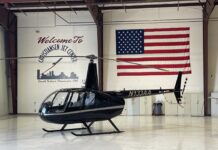Over the next 20 years, according to a recent study by Boeing, there will be a worldwide demand for 763,000 commercial pilots. In North America, the projected number of pilots is 208,000, representing 27% of the global demand.
The Oklahoma Aeronautics Commission (OAC) is looking for innovative ways to meet that demand with several programs and strategies to build the aviation workforce. State Director of Aeronautics for the OAC, Grayson Ardies, says that “for every one pilot in the air, there are eight to nine people on the ground to keep that plane in the air.”
So while pilots may be the most visible members of the aviation workforce, there are a multitude of other roles that are essential to keeping our commercial planes flying.
In addition to supporting the development of the pilot workforce, OAC’s efforts include addressing the demand for skilled labor roles such as mechanics, avionics technicians as well as air traffic control technicians, and also filling important positions in engineering and airport management.
Piloting an aircraft for a living can be a lucrative and rewarding career. Currently, a pilot with an ATP (Airline Transport Pilot) rating can make, on average, about $120,000 per year. However, despite the lure of this field, the industry still struggles to meet demand for pilots for the growing number of aircraft in the skies.
According to Ardies, the current demand for pilots and other aviation industry roles is the result of a series of ebbs and flows in the travel industry dating back to 2001. Several events such as the September 11th attacks, the recession of 2008-2009 and the recent coronavirus pandemic have all wreaked havoc on the stability of the air travel industry. These events, coupled with an aging workforce, have left a serious shortfall in pilots and other aviation professionals. This demand is what the OAC works to address.
One example of their work is providing funding for Oklahoma schools to offer the “You Can Fly” curriculum, developed by the Aircraft Owners and Pilots Association. This program launched at Ada High School in 2017 and, according to Ardies, has grown to over 30 schools statewide, including five “Schools of Excellence” which have been certified in their delivery of this program.
The OAC also offers day camps, and 10-day immersion experiences to expose young people to industry opportunities, which now include robotics training to address the growth of the UAS (unmanned aircraft systems, i.e. drones) industry.
The Oklahoma Aeronautics Commission’s work is vital to the state’s economy, and to keeping the industry fed with qualified professionals to carry Oklahoma into the future.


























